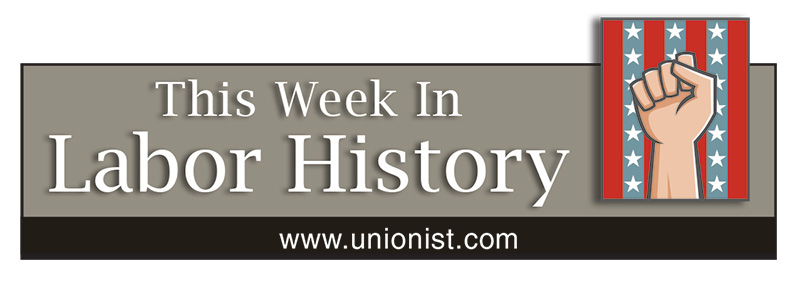
FEBRUARY 6
1896 – Ironworkers from six cities meet in Pittsburgh to form the Int’l Association of Bridge and Structural Iron Workers of America. Their pay in Pittsburgh at the time: $2.75 for a nine-hour day.
1910 – Philadelphia shirtwaist makers vote to accept an arbitration offer and end walkout as Triangle Shirtwaist strike winds down. One year later 146 workers, mostly young girls aged 13 to 23, were to die in a devastating fire at Triangle’s New York City sweatshop.
1919 – Seattle General Strike begins. The city was run by a General Strike Committee for six days as tens of thousands of union members stopped work in support of 32,000 striking longshoremen.
FEBRUARY 7
1894 – Union miners in Cripple Creek, Colo., begin what is to become a five-month strike that started when mine owners cut wages to $2.50 a day, from $3. The state militia was called out in support of the strikers — the only time in U.S. history that a militia was directed to side with the workers. The strike ended in victory for the union.
1904 – It took 1,231 firefighters 30 hours to put down The Great Baltimore Fire, which started on this day and destroyed 1,500 buildings over an area of some 140 acres.
1957 – Hockey players formed the NHL Players Association in New York City after owners refuse to release pension plan financial information. The union was busted when owners transferred key activists, but it successfully re-formed 10 years later.
2008 – Thirteen workers are killed, 42 injured in a dust explosion at an Imperial Sugar refinery in Port Wentworth, Ga. Investigators found that the company had been aware of dangers for years but had not acted on them.
FEBRUARY 8
1912 – Vigilantes beat IWW organizers for exercising free-speech rights, San Diego.
FEBRUARY 9
1917 – Wobbly activist Tom Mooney convicted in bombing frame-up orchestrated by Pinkerton Detective Agency. He was pardoned and released 22 years later.
1937 – Congress approves legislation allowing for a total of $940 million to be used for Depression-era relief projects, with $790 million intended to be used to fund work relief and flood recovery programs.
1950 – U.S. Sen. Joseph McCarthy falsely charged that the State Department was riddled with Communists. It seems that just about everyone else the Wisconsin senator didn’t like was a Communist as well, including scores of unionists. This was the beginning of “McCarthyism.” He ultimately was officially condemned by the Senate and died of alcoholism.
1961 – President Kennedy asks Congress to approve creation of the Medicare program, financed by an increase in Social Security taxes, to aid 14.2 million Americans aged 65 or older.
2000 – Some 19,000 Boeing engineers and technical workers in Washington state and Oregon begin what is to become a 40-day strike over economic issues.
FEBRUARY 10
1908 – The American Federation of Labor (AFL) founds the Building and Construction Trades Department as a way to overcome the jurisdictional conflicts occurring in the building and construction unions.
1963 – Eleven members of the Carpenters’ union in Reesor Siding, Northern Ontario are shot, three fatally, by independent local farmer-settlers who were supplying wood to a Spruce Falls Power and Paper Co. plant. Some 400 union members were attempting to block an outbound shipment from the plant. The action came as the company was insisting on a pay freeze and two months of seven-day-a-week work.
1973 – Forty workers are killed on Staten Island, N.Y., when a huge storage tank filled with liquefied gas explodes.
FEBRUARY 11
1903 – Five hundred Japanese and 200 Mexican laborers unite to fight the labor contractor responsible for hiring at the American Beet Sugar Co. in Oxnard, Calif. They ultimately win higher wages and the right to shop at stores not owned by the company.
1913 – Mary Harris “Mother” Jones is arrested while leading a protest of conditions in West Virginia mines. She was 83 years old at the time.
1913 – Fifteen thousand rubber workers strike in Akron, Ohio, protesting a speed-up.
1919 – The Seattle General Strike ends after six days. Some 65,000 workers struck for higher pay after two years of World War I wage controls.
1948 – “White Shirt Day” at UAW-represented GM plants. Union members are encouraged to wear white shirts, marking the anniversary of the 1936-1937 Flint sit-down strike that gave the union bargaining rights at the automaker. The mission: send a message that “blue collar” workers deserve the same respect as their management counterparts. One of the day’s traditional rules: Don’t get your shirt any dirtier than the boss gets his. The 44-day strike was won in 1937 but the tradition didn’t begin until 1948, at the suggestion of Local 598 member Bert Christenson.
1968 – Some 1,300 sanitation workers begin what is to become a 64-day strike in Memphis, ultimately winning union recognition and wage increases. The April 4 assassination in Memphis of Martin Luther King Jr., who had been taking an active role in mass meetings and street actions, brought pressure on the city to settle the strike.
2011 – Wisconsin Gov. Scott Walker announces he will call out the National Guard, if necessary, to deal with any “unrest” among state employees in the wake of his decision to unilaterally end nearly all collective bargaining rights for the workers.
FEBRUARY 12
1818 – Abolitionist Frederick Douglass born into slavery near Easton, Md.
1880 – John L. Lewis, president of United Mine Workers of America and founding president of the CIO, born near Lucas, Iowa.
(Compiled by David Prosten, founder of Union Communication Services)

